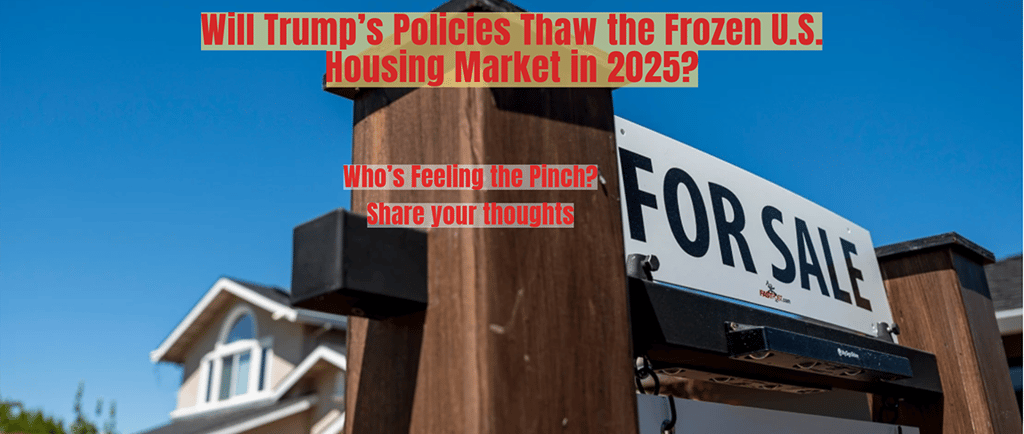Will Trump’s Policies Thaw the Frozen U.S. Housing Market in 2025?
4/22/20253 min read


Will Trump’s Policies Thaw the Frozen U.S. Housing Market in 2025?
The U.S. housing market in April 2025 feels like a car stuck in neutral—engine revving, but barely moving. Home prices creep up at a sluggish 3%, affordability remains a hurdle, and supply shortages linger like an unwelcome guest. With Donald Trump back in the White House, his early policies are shaking things up, from tariffs to tax cuts, but will they jumpstart the market or keep it iced over? Let’s dive into what’s happening, how it’s hitting Americans, and what it means for your dream home.
A Market Still on Ice
The housing market is growing, but don’t pop the champagne. J.P. Morgan Research pegs 2025 home price growth at a modest 3%, a far cry from the double-digit surges of the early 2020s. Median home prices, now about 5.2 times the median household income, are squeezing out first-time buyers. Mortgage rates, after briefly dipping, are back up to 6.6–7% for a 30-year fixed loan, with forecasts suggesting only a slight dip to 6.7% by year-end. Supply is inching up—months’ supply hit 4.1, compared to 3.7 in 2024—but a massive gap of millions of homes persists. Experts say it’ll take over seven years to catch up at current building rates.
For Americans, this means sticker shock and tough choices. Young families are stuck renting, while homeowners with low-rate mortgages from the pandemic era are reluctant to sell, locking up inventory. The result? A market that’s neither crashing nor booming—just stuck.
Trump’s Policies: A Mixed Bag
Since taking office on January 20, 2025, Trump’s policies have been reshaping the housing landscape. Here’s how they’re playing out:
Tariffs and Inflation Pressures: Trump’s proposed tariffs on imports, particularly from China, are driving up construction costs. Lumber, steel, and other materials are pricier, slowing new home builds. This has also pushed mortgage rates back up, as inflation fears ripple through bond markets. For buyers, this translates to higher monthly payments—on a $300,000 loan, a 7% rate means about $150 more per month than at 6%.
Tax Cuts and Deregulation: Trump’s push to extend the 2017 tax cuts and deregulate environmental and zoning rules aims to spur construction. Lower taxes could boost household budgets, potentially increasing demand. Deregulation might ease permitting bottlenecks, encouraging developers to build. However, these are long-term fixes, and critics warn that tax cuts could inflate deficits, nudging interest rates higher.
Immigration Policies: Stricter immigration enforcement could shrink the construction workforce, where 25% of workers are immigrants. This risks further delaying projects and hiking costs, especially in high-demand areas like Texas and Florida.
Who’s Feeling the Pinch?
The impacts vary across demographics:
First-Time Buyers: Young Americans face a brutal math problem. With home prices at $400,000 on average and rates near 7%, a 20% down payment and monthly costs eat up 40% or more of median incomes. Many are delaying homeownership, renting longer, or moving to cheaper regions.
Homeowners: Those who locked in 3% mortgages in 2020–2021 are sitting pretty, with home equity soaring—$305 trillion in homeowner wealth nationwide. But they’re also “rate-locked,” unwilling to sell and face today’s higher rates, which stifles inventory.
Renters: Rising rents, up 4% year-over-year, are squeezing budgets, especially in urban areas. Trump’s tariff-driven inflation could push rents higher, as landlords pass on costs.
Regional Hotspots and Cool Zones
Not all markets are equal. Sun Belt states like Texas, Florida, and Arizona are seeing stronger demand, fueled by migration and job growth, though tariff costs are slowing new builds. Meanwhile, high-cost coastal cities like San Francisco and New York remain unaffordable, with sluggish sales. Smaller markets, like Boise or Raleigh, offer relative affordability but face inventory crunches.
What’s Next for 2025?
The housing market’s trajectory depends on how Trump’s policies unfold. If deregulation accelerates construction, supply could ease by late 2025, cooling prices. But if tariffs and immigration crackdowns dominate, costs will climb, and affordability will worsen. The Federal Reserve’s next moves are also key—if inflation persists, rate cuts could stall, keeping borrowing expensive.
For now, patience is the name of the game. Buyers might find deals in less competitive markets, while sellers with equity can still cash out. But for many, the American Dream of homeownership feels just out of reach.
Thought Questions
How are rising construction costs from tariffs affecting your local housing market?
Should first-time buyers wait for lower rates or jump in now with creative financing?
Will Trump’s deregulation efforts make a dent in the housing shortage, or are bigger solutions needed?
hello@boncopia.com
+13286036419
© 2025. All rights reserved.